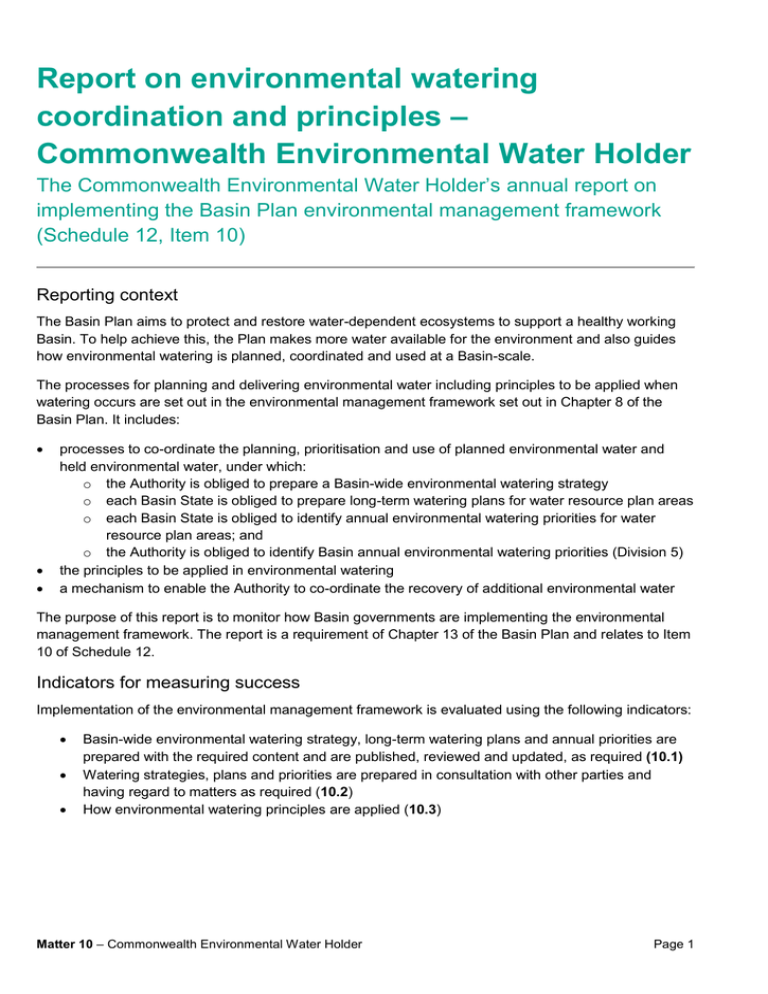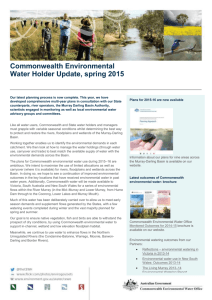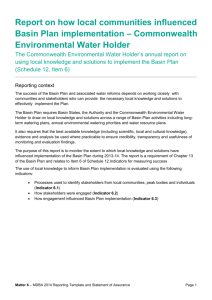CEWH Matter 10 Reporting 2014-15 - Murray
advertisement

Report on environmental watering coordination and principles – Commonwealth Environmental Water Holder The Commonwealth Environmental Water Holder’s annual report on implementing the Basin Plan environmental management framework (Schedule 12, Item 10) Reporting context The Basin Plan aims to protect and restore water-dependent ecosystems to support a healthy working Basin. To help achieve this, the Plan makes more water available for the environment and also guides how environmental watering is planned, coordinated and used at a Basin-scale. The processes for planning and delivering environmental water including principles to be applied when watering occurs are set out in the environmental management framework set out in Chapter 8 of the Basin Plan. It includes: processes to co-ordinate the planning, prioritisation and use of planned environmental water and held environmental water, under which: o the Authority is obliged to prepare a Basin-wide environmental watering strategy o each Basin State is obliged to prepare long-term watering plans for water resource plan areas o each Basin State is obliged to identify annual environmental watering priorities for water resource plan areas; and o the Authority is obliged to identify Basin annual environmental watering priorities (Division 5) the principles to be applied in environmental watering a mechanism to enable the Authority to co-ordinate the recovery of additional environmental water The purpose of this report is to monitor how Basin governments are implementing the environmental management framework. The report is a requirement of Chapter 13 of the Basin Plan and relates to Item 10 of Schedule 12. Indicators for measuring success Implementation of the environmental management framework is evaluated using the following indicators: Basin-wide environmental watering strategy, long-term watering plans and annual priorities are prepared with the required content and are published, reviewed and updated, as required (10.1) Watering strategies, plans and priorities are prepared in consultation with other parties and having regard to matters as required (10.2) How environmental watering principles are applied (10.3) Matter 10 ‒ Commonwealth Environmental Water Holder Page 1 10.1: Basin-wide environmental watering strategy, long-term watering plans and annual priorities were prepared, with the required content, published, reviewed and updated as obligated under Part 4 of Chapter 8, Divisions 2-5 Response Consistent with 8.25(4), the Commonwealth Environmental Water Holder (as a holder of environmental water) has made information on the Commonwealth’s expected holding of environmental water for each Water Resource Plan area available on the Commonwealth Environmental Water Office’s website at http://www.environment.gov.au/water/cewo/portfolio-mgt/holdings-catchment Updated monthly, the website includes: Quantities (ML of entitlements) Reliability (long term average annual yield, ML) Security class / licence type (security definition differs per state) Volume of allocations (including carryover from previous water year) Volumes delivered in current water year Water trading intentions Portfolio management statements were published in July 2014, October 2014, January 2015 and April 2015. Consistent with these statements no trade of water allocations or permanent entitlements occurred in 2014–15. 10.2: Watering strategies, plans and priorities are prepared consistently with Part 4 of Chapter 8, in relation to coordinating, consulting and cooperating with other Reporters and the matters to which regard must be had (Chapter 8, Part 4) 10.2.1. Describe how coordination, consultation and cooperation occurred including with other governments Response Basin-wide environmental watering strategy The Commonwealth Environmental Water Office provided input to the MurrayDarling Basin Authority’s finalisation of the Basin-wide environmental watering strategy through the Basin Plan Implementation Committee and its Environmental Water Working Group. Environmental water planning Annual planning for the Commonwealth environmental water portfolio is undertaken prior to the start of each water year. This planning aims to determine the best use of the available environmental water relative to the identified environmental demands and priorities. This requires consideration of all available portfolio management options—water delivery, carrying water over for use in the next year, or trading water allocations (buying or selling). It also involves consideration of past watering history and future environmental demands. Matter 10 ‒ Commonwealth Environmental Water Holder Page 2 Response Input on environmental demands is primarily provided by: state government agencies (through the catchment annual environmental watering priorities) the Murray-Darling Basin Authority (through the Basin annual environmental watering priorities) regional natural resource management groups, local environmental water advisory groups, Indigenous communities and other interested community members (through stakeholder meetings, including those organised by state government agencies). The Commonwealth Environmental Water Office collaborates and consults with these groups, as well as river operators, other water users, relevant landholders, scientists and non-government organisations, in developing the its portfolio management plans. This collaboration around planning supports the Commonwealth Environmental Water Holder’s input to the development of Basin and catchment annual environmental watering priorities (by the Murray-Darling Basin Authority and Basin States, respectively). Coordination in the delivery and monitoring of Commonwealth environmental water is addressed in Matter 10.3 below. 10.2.2. Describe what difference coordination, consultation and cooperation made Response Collaboration and consultation with relevant and interested parties is critical to the development of the Commonwealth environmental water portfolio management plans. It ensures that the planning undertaken by the Commonwealth Environmental Water Office is based on the same information as its delivery partners and has access to the latest information on environmental demands, risks, constraints, and the activities of other water managers. Through coordinating engagement activities, the Commonwealth Environmental Water Office, the Murray-Darling Basin Authority and state government agencies efficiently access the views of local communities and minimise the risk of duplicative consultation. Matter 10 ‒ Commonwealth Environmental Water Holder Page 3 10.3: How environmental watering principles are applied consistent with Division 6 of Chapter 8, Part 4 10.3.1. Provide at least one case study that demonstrates how environmental watering principles were applied and identify the relevant principles. Response The Commonwealth Environmental Water Holder uses a number of frameworks and processes to ensure the use of Commonwealth environmental water is undertaken consistent with the Principles to be applied in environmental watering as set out in Division 6 of Chapter 8 part 4. The primary mechanism is the Criteria for Assessing Options for Commonwealth Environmental Water Use (‘the Criteria’). This Criteria is an attachment to the Framework for Determining Commonwealth Environmental Water Use and is applied for all Commonwealth environmental watering decisions. A detailed description of how each principle is applied to Commonwealth environmental watering actions, is provided in the Commonwealth Environmental Water Holder’s 2013–14 Basin Plan annual report. Key highlights or new approaches adopted in 2014–15 are provided below. Principle 1—Basin annual environmental watering priorities Commonwealth environmental water contributed to six of the seven Basin annual environmental watering priorities for 2014–15. Evidence against this is provided in the Commonwealth Environmental Water Holder’s Statement of Assurance. Principle 2—Maximising environmental benefits (through coordination) The coordination of environmental watering occurs through multiple mechanisms, including bilateral discussions with environmental water holders and river operators, operational advisory groups and established committees. The Commonwealth Environmental Water Holder is a member of the Southern Connected Basin Environmental Watering Advisory Committee, which was established in 2015. The Committee provides a formal mechanism to coordinate planning for the delivery of environmental water so that it is consistent with the Basin Plan Environmental Management Framework. The Committee includes representatives from all relevant environmental water managers and river operators in the southern-connected Basin. Principle 7—Working effectively with local communities The Commonwealth Environmental Water Holder regularly meets with individuals and representatives of local government, business, landholders, Aboriginal communities and peak bodies, to discuss the planning, management, and monitoring of Commonwealth environmental water. The Commonwealth Environmental Water Holders outreach activities are complemented by the work of six local engagement officers. These officers are located in the following regional centres of the Murray-Darling Basin: Goondiwindi, Dubbo, Leeton, Deniliquin, Mildura and Berri. Between them, the local engagement officers cover the majority of regions in the Basin where Commonwealth environmental water is held. Matter 10 ‒ Commonwealth Environmental Water Holder Page 4 Response Principle 8—Adaptive management On-ground monitoring commenced across the Murray-Darling Basin early in the 2014–15 water year as part of the Commonwealth Environmental Water Holder’s $30 million Long-term Intervention Monitoring Project. Under this Project, a consortium of monitoring teams, led by leading research institutions and including local land and water managers, have been engaged to implement 5-year monitoring and evaluation plans for the following seven selected areas within the Basin: Lower Murray River Goulburn River Edward-Wakool river system Murrumbidgee river system Lachlan river system Gwydir river system Junction of Warrego and Darling rivers. Case Studies Adaptive management and local engagement in practice—environmental watering in the Goulburn River The Commonwealth Environmental Water Holder works closely with the Victorian Environmental Water Holder and local delivery partners—the Goulburn Broken Catchment Management Authority and the river operator, Goulburn Murray Water— through an operational advisory group to design and manage environmental watering events in the Goulburn River, and to monitor and evaluate the effectiveness of Commonwealth environmental water use. When planning for environmental water use in 2014–15, all the parties got together and reviewed the lessons of the past three years of spring flows. This review noted: After several unsuccessful attempts in previous years, an environmental flow delivered in spring of 2013 supported golden perch breeding. The peak of the flow event had been increased as compared to previous years. The need for continuing recovery of riverbank vegetation, which remains in poor condition following prolonged drought and subsequent floods during the last decade. Community members had raised concerns of riverbank erosion (bank notching and slumping). Recreational fishers had raised concerns that environmental flows delivered during the opening of the Murray cod fishing season had disrupted local angling events. In response, the first spring environmental flow in 2014 was brought forward to Matter 10 ‒ Commonwealth Environmental Water Holder Page 5 Response October, instead of November, and was delivered as a flow pulse (fresh) with a gradual recession. This watering action was intended to maximise outcomes for riverbank and in-channel vegetation (ensuring it received water before the hot summer), which in turn provides fish habitat and also reduces the risk of riverbank erosion. A second spring flow pulse was timed for late November, to take advantage of warmer water temperatures to support golden perch spawning. The flow was specifically designed to ensure environmental watering did not coincide with the start of the Murray cod-fishing season on 1 December. Monitoring in 2014 identified the largest spawning of golden perch in the region since 2010, which occurred during the November environmental flow. Community members did not raise any concerns regarding riverbank erosion and reported that ‘it was the best fishing in years’. Maximising environmental benefits—achieving multiple outcomes in the northern Basin In order to maximise the benefits from Commonwealth environmental water, consideration is given to opportunities to achieve outcomes both within a catchment as well as at downstream locations. This has been common practice in the southern Basin for a number of years, and in 2014–15, it was demonstrated that this could also be successfully achieved in the northern Basin. For example, in the Gwydir catchment, Commonwealth environmental water was delivered to the Mehi River (13 gigalitres) and Carole Creek (4 gigaltires) in October 2014, in conjunction with irrigation water, to benefit native fish (such as spangled perch and bony bream). These flows also resulted in connection with the Barwon-Darling River. The connection provided opportunities for native fish movement and dispersal, as well as the transfer of nutrients and organic matter. This particular event activated the Brewarrina fishway at a crucial time of the year for native fish migration. It also improved water quality at a time when the Barwon-Darling River had ceased to flow. Similar outcomes were also achieved from Commonwealth environmental watering in the lower Balonne. Over 17 gigaltires of Commonwealth environmental water contributed to a series of small instream flow pulses in February 2015. These flows significantly increased the volume entering the system and helped ensure that flows reached the end of system in all distributary channels. This included the Birrie and Bokhara rivers, which had not experienced flows through the system for almost two years. The extra environmental water contributed to the filling and reconnection of waterholes throughout the system, providing opportunities for dispersal of fish and other aquatic biota after a long period of no flow. Commonwealth environmental water also improved inflows from the Culgoa River into the Barwon–Darling and extended the period of hydrological connection, during which fish and other aquatic species could move between the two systems. These two environmental watering events demonstrated the hydrological connectivity benefits of Commonwealth environmental water for native fish. The lessons from these watering events are now informing future planning across the northern catchments and supporting further investigations to coordinate flows into the Barwon-Darling. Maximising environmental benefits (through coordination) to improve the population of an endangered native fish— the Murray hardyhead Matter 10 ‒ Commonwealth Environmental Water Holder Page 6 Response The Murray hardyhead is a small native fish found only within the floodplains of the southern Murray-Darling Basin. It was once widespread and abundant in the Murray and Murrumbidgee river systems but has suffered a serious population decline over the past 50 years, and is now nationally endangered. The Murray hardyhead is identified as a key native species in the Basin-wide Environmental Watering Strategy. The Strategy identifies the following broad outcomes for native fish by 2024: no loss of native species improved population structure, increased movement and expanded distribution of key species. The Strategy specifically identifies the need to establish 3–4 additional populations of Murray hardyhead. In 2012, Murray hardyhead that had been bred in captivity by the Murray-Darling Freshwater Research Centre, were re-introduced to two wetlands in the South Australian Riverland, near Berri. Following the conservation efforts by the South Australian government and the delivery of Commonwealth environmental water, monitoring at the two sites in February 2015 identified record numbers of Murray hardyhead. This promising monitoring result presented an ideal opportunity to relocate a portion of the Murray hardyhead and establish a new population. The Mallee Catchment Management Authority has been working in collaboration with environmental water holders to restore wetlands in the Victorian Mallee using Commonwealth and Victorian environmental water. One of these restoration sites, Brickworks Billabong, now provides an ideal habitat for Murray hardyhead. This follows the installation of a new regulator (to allow more natural wetting and drying cycles in the wetland) and initial environmental watering in 2014 (to promote the establishment of aquatic vegetation that would provide habitat and food for Murray hardyhead in the future). In preparation for the fish being translocated, more Commonwealth environmental water was delivered to Brickworks Billabong in March 2015 to further boost habitat and enhance food supply. This was then followed by the Murray-Darling Freshwater Research Centre and South Australian government staff capturing and relocating a sub-population of Murray hardyhead from the Riverland to Brickworks Billabong. Approximately 2500 Murray hardyhead were carefully transferred into an oxygenated water-holding trailer, designed specifically for the transportation of live fish, and generously provided by the Victorian Department of Environment, Land, Water and Planning. Early results indicate that the translocation appears to have been successful, with monitoring in August 2015 detecting juvenile Murray hardyhead (estimated to be 2–3 months old). The translocation was made possible through the collaboration of the following organisations: Murray-Darling Freshwater Research Centre South Australian Department of Environment, Water and Natural Resources Victorian Department of Environment, Land, Water & Planning Matter 10 ‒ Commonwealth Environmental Water Holder Page 7 Response Mallee Catchment Management Authority Commonwealth Environmental Water Holder Parks Victoria Victorian Environmental Water Holder Principle 1: Environmental watering to be undertaken having regard to the Basin annual environmental watering priorities Principle 2: Consistency with the objectives for water-dependent ecosystems Principle 3: Maximising environmental benefits Principle 4: Risks Principle 5: Cost of environmental watering Principle 6: Apply the precautionary principle Principle 7: Working effectively with local communities Principle 8: Adaptive management Principle 9: Relevant international agreements Principle 10: Other management and operational practices Principle 11: Management of water for consumptive use Matter 10 ‒ Commonwealth Environmental Water Holder Page 8






